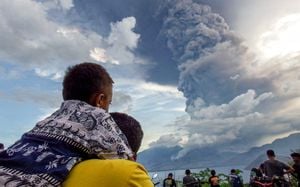Underneath the dusty landscapes of Stilfontein, South Africa, lies the harsh reality of illegal mining, where hundreds of individuals have chosen perilous subterranean lives over the struggle for scarce jobs. This clandestine world has recently drawn national attention, not just for its dangers but for the government's controversial response to the crisis surrounding these miners, commonly referred to as zama zamas, which is often utilized to describe those engaged in informal mining.
The situation escalated dramatically when reports emerged claiming as many as 4,500 illegal miners were trapped underground. Initially, community members echoed these alarming figures, prompting widespread concern. Yet, officials from the South African Police Service (SAPS) swiftly revised these estimates, stating the number of miners underground is actually between 350 and 400—far fewer than the community's claims. Brigadier Athlenda Mathe confirmed this adjustment, declaring previous estimates exaggerative without outright denying the presence of illegal miners.
Despite offers of food and water delivery to these underground miners, their rejection has baffled authorities. Efforts made by police included sending negotiators and even crafting posters pleading for their safe exit. Yet, all entreaties have seemingly fallen on deaf ears. Police are now left grappling with the reality of enforcing law and order amid rising tensions and isolated miners unwilling to resurface.
This underground crisis is compounded by the death of at least one miner, with speculation surrounding several other fatalities. Many observers fear the next phase of this standoff could lead to tragedy, particularly if miners remain deprived of basic necessities.
Some argue the situation has its roots deep within the economic hardship South Africa faces. A backdrop of high unemployment—often rendering the formal labor market inaccessible—has worsened over recent years. The desperation of former mine workers and community members has led to dangerous illegal mining activities, as individuals bet their lives against the hopelessness above ground. South African authorities have now launched Operation Vala Umgodi, aimed at combating illegal mining. This operation has taken on aggressive tactics, reportedly involving drastic measures like limiting basic supplies to miners underground to force them out.
South African officials have faced mounting criticism, particularly from rights organizations like the South African Human Rights Commission, which announced it would investigate reports of the government cutting off food and water supplies for nearly three months as part of its crackdown on the illegal mining phenomenon. The commission's move signals serious concerns over the humanitarian aspects of these enforcement strategies.
Responses to the crisis have also drawn attention to the broader narratives about governance and accountability. Activist groups have found the government's stance particularly disheartening, spotlighting comments from Minister Khumbudzo Ntshavheni, who publicly declared, "We're not sending help to criminals. We're going to smoke them out." Critics interpreted this as evidence of governmental indifference toward the dire conditions facing the miners.
Unions representing mine workers have vehemently condemned the government's approach, calling it callous and irresponsible. Zwelinzima Vavi, General Secretary of the South African Federation of Trade Unions, described the government's failure to engage community leaders and the miners themselves as nothing short of cruel. Vavi asserted the need for constructive communication instead of punitive measures. "Community leaders made countless offers to help bring the mineworkers to the surface, but the response has been to remove their structures and impede any assistance they could provide," he stated, calling the government's actions effectively vindictive.
The unions' position highlights the tug-of-war between law enforcement and community support for individuals engaged in these risky mining operations. Many see the zama zamas not merely as criminals, but as products of systemic failures—pushed to extreme measures to survive as economic anxiety festers within the communities. Reports indicate artisan mineworkers, long disconnected from stable income sources, are now experiencing dehydration and weakness from their extended isolation underground.
While bold initiatives to tackle illicit mining may seem necessary on the surface, the fallout from these developments serves as a reminder of the broader social issues at play. Who bears responsibility for the dire exchanges between safety, survival, and livelihood? At what point does law enforcement turn to compassion?
With reports remaining fluid and the situation increasingly dire, the tension surrounding the Stilfontein mine continues to evolve. The community, caught in this dangerous crossfire, faces difficult decisions as the government grapples with how to restore order from chaos and make sense of this rugged, underground world.



